Translated and Sourced from Mizuki Shigeru’s Mujyara, Kaii Yokai Densho Database, Japanese Wikipedia, and Other Sources
At the Hour of the Ox (between 1-3 A.M.) a lone figure creeps silently towards a sacred tree. She is dressed in white, and on her head an upturned trivet is worn like a crown, three candles burning in the night. In one hand, she carries a doll made of bound straw in the form of a person; in her other hand, a small wooden hammer and a set of long, iron spikes. The hatred in her heart blazes brighter than the candles, appropriate for one completing the curse-ritual known as Ushi no Koku Mairi, the Shrine Visit at the Hour of the Ox.
The Ritual
Ushi no Koku Mairi (丑の刻参り; also known as 丑の時参; Ushi no Toki Mairi, both of which translate as Shrine Visit at the Hour of the Ox) is an ancient, famous, and terrible Japanese curse-ritual. It has been performed for millennia—some sources trace it back as far as the Kofun period (250 – 538 CE), although in a different form. While the costume and ritual have changed over the centuries, the basic rite of pounding nails into dolls remains the same.
To perform an Ushi no Koku Mairi, you first make a straw doll (藁人形; waraningyo) to serve as an effigy of the person you want to curse. For the best effect, the doll should have some part of the person in it, some hair, skin, blood, fingernails, or other DNA. In a pinch a photograph will do, or even their name written on a piece of paper. This done, you done the ritual costume, and sneak into a shrine late at night. Many Shinto shrines have sacred trees, called shinboku, that are the homes of kami spirits. Nail the doll to the sacred tree using long, iron spikes called gosunkugi (五寸釘).
As stated in the name, the timing is very important. The ritual can only be completed at the Hour of the Ox, between 1-3 A.M. in the ancient method of counting time in Japan. The Hour of the Ox is the traditional Witching Hour in Japan, a time when yurei and yokai and other evil spirits come haunting.
And most importantly—the ritual must be done in secret; it is said that if anyone sees you performing Ushi no Koku Mairi, the curse will rebound on the caster. Unless, of course, the eyewitness is immediately slain.
How many times you perform the ritual vary; some say that you must go back seven nights, pounding in a single nail each night. The final nail goes into the head, which will kill the cursed person. The results of the curse vary as well—some say the cursed person will sicken and die. Some say that, like a Voodoo doll, the cursed person will feel pain where the spikes are hammered in. Some say it is a summoning ritual, and that performing an Ushi no Koku Mairi summons a vengeful spirit to torment and ultimately destroy the recipient.
The Costume
An important component to the ritual is the costume. One does not simply waltz into a shrine and pound a doll into a tree. The costume is a demonstration of your intention, and is more than just decoration; the curse is said to be so terrible that in order to be effective you must become a demon yourself.
Although the costume has changed over the years (and there are numerous variations depending on your source), the most recognizable version comes from the Edo period, and is still associated with the ritual.
• A white kimono and obi, with your face painted white (to look like a supernatural creature)
• An upturned trivet on your head, with three candles burning on the legs
• A mirror (a sacred symbol of Shinto) worn over your chest like a necklace
• A shortsword tucked into your sash, to kill anyone that sees you
• Tall, one-toothed geta clogs (or barefoot, if you can’t walk in them)
• A wooden comb (in some accounts, a razor) held between your teeth (It is important not to utter a sound once you enter the shrine, and the comb keeps you silent.)
Some variations of the costume swap out a headband and two candles for the trivet, but I think if you are going to do it, go all out.
The History of Ushi no Koku Mairi
No one really knows how old the ritual really is. In the Nara National Research Institute for Cultural Properties, the is an 8th century relic from an archeological dig of a doll made of bound wooden strips with an iron nail shoved through the chest. This is from a time when iron had just been introduced into Japan, and would have been a rare commodity. In the ruins of Datecho in Shimane prefecture, Matsue City, archeologists found a wooden plaque with a painting of a court lady that had wooden spikes pounded through it. It is known that dolls for curses were used by Onmyoji , the yin/yang sorcerers of the Heian period (794 – 1185 CE).
Going to the shrine at the Hour of the Ox has not always been associated with curses, however. Old records show that people originally snuck in to pray, and that during these nighttime visits your pleas to the kami were more likely to be answered. Somehow, along the way, these prayers for a kami’s blessing turned into prayers for a kami’s curse.
One of the oldest written accounts of the ritual comes from the Sword scroll of the Kamakura period epic poem The Tale of the Heike. It differs from modern accounts—the costume calls for you to bind your hair into five braids, to use bound-together pine branches threaded into an iron ring for torches, and to cake your face in red vermillion clay instead of painted white. Also, instead of a late-night sneak visit to a shrine, the curser runs down the street shouting their curse for all to hear. According to the story, the ritual was taught to a woman by a kami spirit, after she prayed for revenge at a local shrine. The woman would transform into the monstrous Hashi Hime (Bridge Princess), still wearing her frightful costume.
In the Muromachi period (1337 to 1573 CE), a Noh play called Kanawa (鉄輪; Iron Ring)is credited with drawing a connection between the Onmyodo doll ritual and the costume of the Hashi Hime, creating the first account of the Ushi no Koku Mairi as it is known today.
By the Edo period, the Ushi no Koku Mairi was firmly established and illustrated by artists in kaidan-shu collections of stories of the strange. One of the main differences in Edo period artists was the results of the ritual—many preferred to show some evil spirit or god lurking in the background, waiting to be summoned by the completed ritual.
Where to Perform the Ritual
Not all shrines are created equal for Ushi no Koku Mairi. Kifune Jinja in Kyoto and Ikurei Jinja in Niimi, Okayama, are famous sites for Ushi no Koku Mairi, as is Jishu Jinja, a small shrine located near the Kyoto Buddhist temple Kiyomizudera. If you look carefully, these sacred sites have shinboku trees that still bear the scars of centuries of iron nails pounded in by vengeance-seekers.
And if all this seems like a lot of work to put together, don’t worry. In the modern world, a complete Ushi no Koku Mairi kit can be ordered online. But be careful, performers of the ritual can be prosecuted under Japanese law.
Translator’s Note
The Ushi no Koku Mairi was a difficult project–difficult in knowing what to leave in, and what to leave out. There are SO many different variations on the ritual it would be impossible to include them all. I tried to add in what I thought was relevant, and appeared in the highest number of resources. But this is by no means a complete account.
This is the second of my trivet-wearing yokai stories. Next up is a direct ancestor of the Ushi no Koku Mairi, the Hashi Hime.
Further Reading
For related kaidan stories, check out
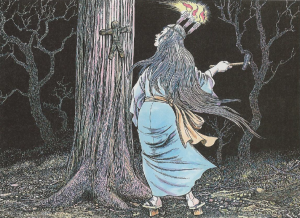
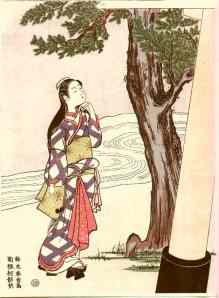
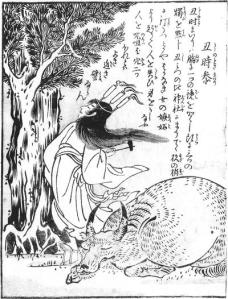

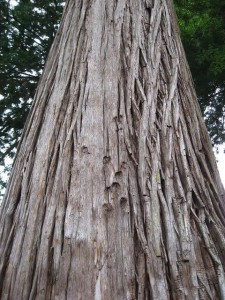
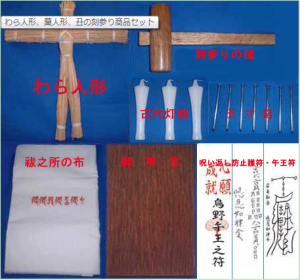

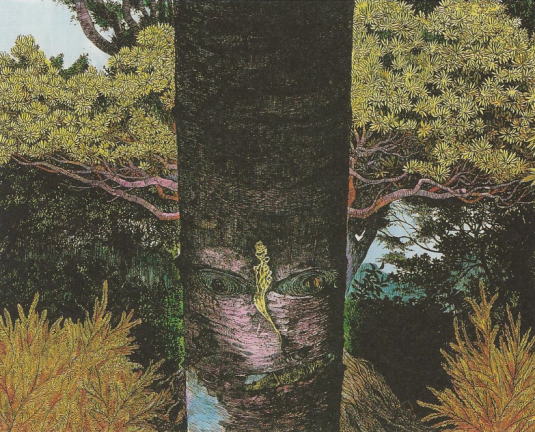
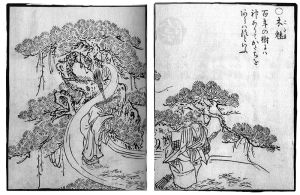

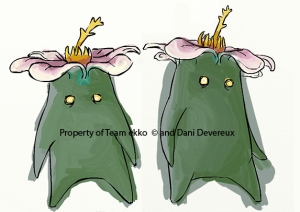






Recent Comments